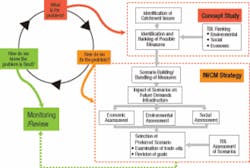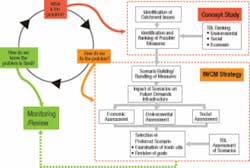Quenching Australia’s thirst
Australia’s long-term drought requires creative, innovative approaches to urban water planning. Water conservation, recycled water, stormwater, and rainwater must have an important role to play in order to quench the nation’s thirst for freshwater supplies in a sustainable way.
Current drought conditions throughout Australia have forced a change in thinking on urban water issues and have highlighted the many challenges in providing a balance between supply and demand in the world’s most arid continent.
Most of the country’s inhabitants live in concentrated areas along the wet coastal fringe, however some sizeable towns are situated in the dry interior. Large areas of Australia have spent a significant part of the last 15 years in drought, while rainfall in the last three years has been well below average.
In addition, with only 100 years of rainfall record to rely on, this type of drought is rapidly re-writing the hydrologic records upon which the yields of surface water supplies are based. The low rainfall and high levels of surface and groundwater extractions are leading to the hydrological stress of aquatic ecosystems. This high state of hydrologic stress means that the augmentation of existing water supplies with additional surface water extractions and storage would be problematic. The country is rapidly approaching a water supply crisis with permanent water restrictions becoming part of normal life.
The water shortages have led to resource managers making significant changes in the planning and management of urban water resources. These changes have highlighted many deficiencies in the water industry’s ability to plan and implement new types of infrastructure.
New tools are being developed to achieve more integrated water resources planning. The application of these tools is providing insights into alternative ways of supplying traditional water, wastewater and stormwater services.
So far, traditional water, wastewater, and stormwater management have been undertaken in a piecemeal manner, which worked adequately in an environment where surface water extractions and wastewater and stormwater discharges were low in proportion to natural flow regimes. However, new, more integrated approaches are required for ecosystems undergoing hydrologic and environmental stress.
In all areas of Australia, it has become routine practice to examine the impact of demand management and source substitution measures in water resources planning. The New South Wales (NSW) Department of Energy, Utilities and Sustainability recently issued Integrated Water Cycle Management (IWCM) guidelines for urban water utilities (DEUS 2004). The planning process is based on achieving a better understanding of demand drivers and of the outcomes of activities, such as water conservation; source substitution (water recycling and rainwater use); system leakage management; water pricing changes; wastewater management; and water-sensitive urban design (WSUD). It looks at integration of supply security and water quality outcomes; stakeholder engagement on the planning process; and a triple bottom line assessment of the outcome. The process provides a framework where stakeholders can examine the tradeoffs inherent in environmental, social, and financial outcomes of different water futures.
While the current drought has spawned significant efforts in looking at new approaches, lack of skilled water resources planning has resulted in:
- Optimism in forecasts and a tendency to underplay costs;
- Poor understanding of demand drivers, in particular the upward pressures on demand as a result of income and lifestyle factors;
- Little information on how water is used in the non-residential sector and the actions that might be employed to curb consumption;
- The lack of transparent reporting frameworks upon which a high quality assessment of the impact of demand management efforts can be made.
The IWCM planning process has driven the need for new planning tools for the provision of vital inputs at key parts of the process. The end-use based demand forecasting methodology has become the industry best practice. In end-use forecasting, the total water demand is broken down into different consumer categories and then into individual uses within these categories. The benefit of this approach is that it allows for expected changes in the demographic make-up of supply areas, and the type and ownership of water using fixtures and appliances. Most importantly it facilitates the assessment of the impact of water conservation and source substitution scenarios.
Parkes Integrated Water Cycle Management Strategy
The municipality of Parkes in NSW has a population of approximately 12,000 people with water supply system that provides water to 10,000 people in the townships of Parkes and Peak Hill. The water supply system is also used to supply water to the North Parkes Mine.
Parkes is located in the temperate climate region in the midwest of NSW, characterized by hot dry summers and cold winters. Annual rainfall is approximately 580 mm. Two surface water supplies to the east of the town (Lake Endeavour and Lake Metcalf) and a borefield located in the alluvial sediments on the Lachlan River supply water to Parkes.
In more recent times, due to low levels in the two dams and falling levels in the borefield aquifer, the town installed a temporary extraction from the Lachlan River. Falling levels in the aquifer are thought to be a result of both low levels in the Lachlan River and increased borefield extractions by irrigators.
In 2003, Parkes Shire commenced the development of an Integrated Water Cycle Management Strategy. The Parkes IWCM study was seen as an opportunity to address the issue of critical supply shortfalls in a whole water cycle context. The study generated a number of scenarios, each representing a different water future, with increasing levels of water cycle integration. Each of the scenarios provided increasing reductions in water demand and improvements in environmental outcomes.
The resulting financial outcomes clearly demonstrated that the use of a variety of demand management and water recycling initiatives would result in better financial outcomes with considerable environmental benefits. This was primarily due to benefits associated with the downsizing of the proposed transfer system from the Lachlan River to the town and the optimization of water and wastewater treatment systems to provide fit-for purpose recycled water for a number of urban uses.
South East Queensland Regional Water Supply Strategy
The South East Queensland region currently has the strongest population growth in Australia, while water supply storage levels have fallen to historical lows. This situation has created great pressure on supply security and aquatic ecosystems. In addition, water quality in the sensitive ecosystems of Moreton Bay is poor from a combination of agricultural, urban land use and wastewater treatment plant discharges. The streams, estuaries, and marine environments in South East Queensland are a high priority for protection due to their unique environmental values and importance for recreation and tourism. The regional climate is sub-tropical with an annual rainfall of approximately 1,200 mm.
In developing a strategy for providing a future balance between supply and demand, a wide range of initiatives were considered to reduce demand through improved water efficiency and the amplification of supply. These include:
- The impact of the national mandatory Water Efficiency Labelling Scheme (WELS) and the Queensland Sustainable Housing Code;
- The introduction of an inclining block tariff for residential users;
- The mandatory use of rainwater harvesting systems in infill development areas;
- The use of dual reticulation with recycled water in new development areas;
- Community education programs;
- Water system loss management; and
- Residential retrofit programs;
The final strategy will depend on an assessment of the outcomes for:
- Environment effects: reductions in pollutants entering waterways, extractions, greenhouse gas emissions;
- Social effects: public health, lifestyle, household budgets;
- Economic: effect on economic growth, rates, and charges.
Solutions adopted from Parkes and Queensland studies showed effluent recycling to be an important element in overall solution development. As the use of effluent recycling is increasing, national and state guidelines have been developed to provide a basis for upgrading the treatment plant.
The use of rainwater and recycled water has important roles to play not only in reducing water use, but improving regional water quality outcomes. Rainwater harvesting systems connected to toilets, washing machines, and outdoor uses have been shown to significantly reduce peak stormwater discharges and improve water quality outcomes (WMB 2005). Pollutant loads to receiving waters can be reduced significantly by recycling treated wastewater in new development areas.
Many positive developments have resulted from pressures created from the recent drought, although there is still scope for improvement:
- Wide recognition that demand management must be integrated into water resources planning. In many cases this has been accompanied by a detailed assessment of the cost-effectiveness of water conservation and recycling.
- Most water utilities lucky enough to be emerging from the recent drought are moving to permanent low-level restrictions on water use. These include limited irrigation times and restrictions on the use of water for cleaning impervious surfaces.
- Demand management and community education programs are becoming more commonplace.
- Recognition of the essential role of water price in encouraging water use efficiency.
- Increasing recognition of the concept of Integrated Water Cycle Management (IWCM) as a water resource planning framework.
- Significant volumes of recycled water are being supplied throughout Australia.
- Introduction of a national mandatory water efficiency labeling scheme that will provide consumers with more information about the water efficiency of fixtures and appliances.
Many positive advances have been made, although there is still scope for improvement.
Conclusions
While the environment has resulted in much creativity and the development of new approaches to urban water planning, there is still some way to go before water planning can be undertaken in a truly integrated manner. Typically, the tools used by the industry to undertake integrated planning fall well short of the standard required to develop reliable forecasts of the costs and benefits of more sustainable approaches to urban water management. There are some notable exceptions with innovative work being done in the understanding of demand drivers and the development of decision support systems for urban water management.
The Parkes and Queenland case studies demonstrate that outcomes can be improved if the urban water cycle can be examined from a fresh perspective. Water conservation, recycled water, stormwater, and rainwater use will all have an important role to play if the urban thirst for water is to be quenched in a more sustainable way.
Significant challenges remain in the political arena, where both politicians and the electorate have to come to terms with the increased level of investment in environmental outcomes that is required. Communities more engaged with issues, such as recycled water and water pricing, can only overcome these challenges.
Authors’ Note
Russell Beatty is the leader of the Water Sustainability for MWH Australia, located in Sydney, Australia. Ajay Nair, is the principal process engineer for MWH UK, based in Brighton, UK. For further information please contact [email protected]


